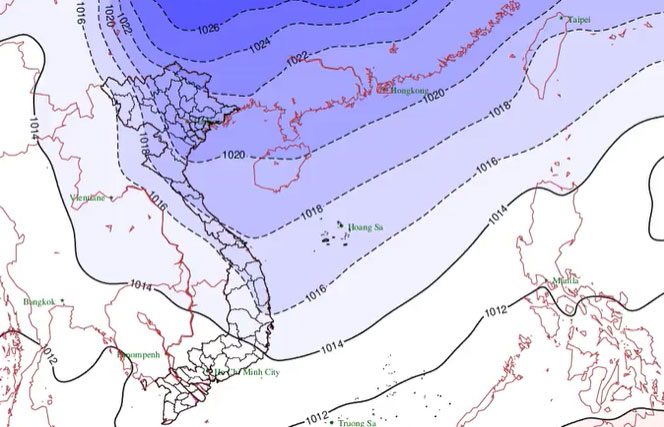A cold air mass is moving down to the North, causing scattered showers and thunderstorms in the Northern provinces starting from Friday, February 24.
According to the National Center for Hydro-Meteorological Forecasting, the weekend in the North will see temperatures ranging from 13-16 degrees Celsius, with mountainous areas at 10-13 degrees Celsius, and high mountainous regions below 9 degrees Celsius. The area from Quang Binh to Thua Thien Hue will generally experience temperatures of 15-18 degrees Celsius.
The American website Accuweather forecasts that Hanoi’s temperature today will range from 17-24 degrees Celsius, with the maximum temperature dropping to 22 degrees Celsius tomorrow. Following that, daytime temperatures will rise to 24-25 degrees Celsius, while nighttime temperatures will be between 13-14 degrees Celsius. In locations over 1,500 meters above sea level, such as Sa Pa (Lao Cai), the lowest temperatures will drop to 6-11 degrees Celsius.

A cold air mass is sweeping down to the North. (Photo: NCHMF)
The North Central provinces will also be affected by the cold air starting February 24, with temperatures generally between 13-16 degrees Celsius. Areas from Ha Tinh to Quang Ngai will experience showers and thunderstorms, with the possibility of whirlwinds, lightning, hail, and strong gusts.
In the Gulf of Tonkin, the northeast winds are gradually increasing to level 6, with gusts reaching level 7 and 8-9. The sea waves will rise to 2-3.5 meters. The Northern East Sea (including the waters of the Paracel Islands) will see northeast winds of level 6-7, gusting to level 8-9, with sea waves reaching heights of 4-6 meters.
The waters from Quang Tri to Ca Mau, the central area of the East Sea, and the western waters of the South East Sea (including the waters west of the Spratly Islands), will experience northeast winds gradually increasing to level 6, with some reaching level 7 and gusts of level 8-9, and sea waves reaching heights of 3-5 meters.
The meteorological agency forecasts that over the next month, average temperatures across most of the country will be close to the long-term average. Specifically, the Northwest region will be 0.5-1 degrees Celsius higher, while Central and Southern Central provinces will be 0.5-1 degrees Celsius lower.
Since the beginning of 2023, there have been four cold air waves affecting Vietnam. The cold wave on January 23, reinforced on January 26, caused severe cold and frost in the Northern provinces and North Central provinces, with the lowest temperatures in some places dropping below 3 degrees Celsius and in high mountainous regions dropping below 1 degree Celsius.


















































